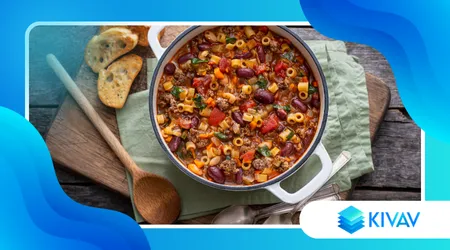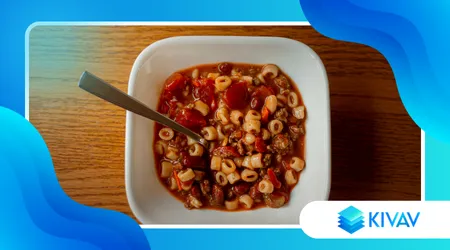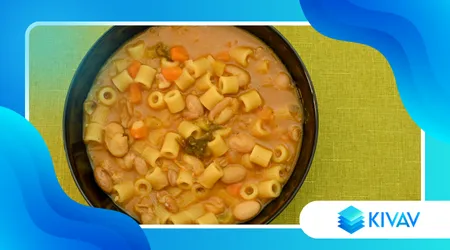Pasta and beans, Neapolitan style: the humble dish that conquered Italy

The irresistible call of the Neapolitan Pasta and Beans inaugurates a journey into the heart of Italian cuisine.
Announcements
This dish, emblem of the Campanian tradition, tells stories of resilience and authentic taste.
Its simplicity hides a culinary depth that goes beyond the mere recipe. It's a celebration of the ability to transform a few ingredients into a symphony of flavors.
Poor Roots: From the Earth to the Table
The history of popular cuisine is woven of necessity and ingenuity. Neapolitan Pasta and Beans emerges precisely from this context.
It originated in humble kitchens, where nothing was wasted. Beans, an accessible source of protein, were a cheap alternative to meat.
Announcements
Southern Italy, historically less wealthy, elevated the legume to the leading role.
Its union with pasta, also a staple food, was inevitable. This combination nourished entire generations with substance and flavor.
The recipe has evolved, but its spirit remains unchanged. It speaks of the land, of industrious hands, and of peasant wisdom. It is a gastronomic masterpiece of the poor cuisine elevated to art.
Secrets and Variations: The Magic of Creaminess
What sets the Neapolitan version apart is the final consistency of the dish. It's not a liquid soup, but a dense and enveloping preparation. The beans are not drained, but partially blended.
This natural process gives a creaminess unique and unmistakable.
Many modern chefs achieve this effect with fats or starches, but here it's nature that does the work. It's the starch released by the beans themselves, and by the pasta, that creates the magic.
Another crucial element is the fat used for the soffritto. Traditionally, pork rind or lard was used.
This gives the dish a robust and persistent flavourNowadays, extra virgin olive oil is often chosen.
Learn more: Trofie with Speck and Walnuts: A Lighter and Tastier First Course
The choice of pasta is a heated debate among purists. Many prefer mixed pasta, 'mmescafrancesca, for a mix of consistencies.
Others choose short pasta, such as tubetti or ditalini, to maximize the absorption of the sauce.

Cultural Impact and Contemporary Rediscovery
This dish has transcended regional borders. Neapolitan Pasta and Beans It's now a national classic. Its simplicity makes it universal, a comfort food par excellence.
It's fascinating to note how humble dishes are the most sought after today.
In an increasingly complex gastronomic world, there's a return to simplicity. This trend reflects a desire for authenticity and roots.
Great restaurants include it in their menus, revisiting it with respect. Maintaining the essence while innovating is the challenge.
Learn more: Tuscan Pici with White Ragù: A Rustic First Course with Authentic Flavors
For example, a famous chef from Campania recently proposed a deconstructed version, serving the bean cream separate from the crunchy pastry.
Another example of reinterpretation: the addition of dried tomato powder.
This intensifies the umami without altering the creaminess. It's a bridge between the most austere tradition and modern sensibility.
Relevant Statistics: According to a 2024 survey on Italian food preferences, 68% of respondents consider legume and pasta-based dishes to be “extremely comforting.”
This fact underlines its enduring emotional appeal.
Comparison with Other Regions and Neapolitan Superiority
Many Italian regions have their own version of pasta e fagioli. Each has its own peculiarities, but the Neapolitan one has a something more.
The Venetian version, for example, is more liquid and often uses borlotti beans.
In Tuscany, however, cannellini beans take center stage. The crucial difference lies in the texture and the expert use of tomatoes.
Interesting: Ricotta Desserts: 5 Ideas
In Naples it is often used, but in a discreet way, to color without dominating.
There Neapolitan Pasta and Beans It's like an old blanket. It wraps you in warmth and familiarity on a cold evening. In contrast, some Northern versions are more like a light broth.
It's an apt analogy: while the Venetian version is an elegant light coat, the Neapolitan one is a heavy hand-knit sweater.
Both protect, but in completely different ways.
The Health and Sustainability of an Immortal Dish
Besides the taste, this dish is a model of nutrition.
Beans are rich in fiber and plant-based protein. Together with pasta, they make a complete and balanced one-dish meal. It's an excellent example of the Mediterranean diet.
This dietary model is recognized by UNESCO as Intangible Heritage of Humanity since 2010. The combination of cereals and legumes is the basis of this excellence.
| Nutritional Component | Medium Portion (350g) | RDA Percentage (Average Adult) |
| Proteins | ||
| Fibers | ||
| Complex Carbohydrates |
How can you deny the perfection of a dish that combines history, flavor, and well-being? It's a rhetorical question, because the answer is obvious.

The Legacy of Pasta and Beans Neapolitan Pasta and Beans
There Neapolitan Pasta and Beans It's more than just a dish. It's a symbol of an Italy that knows how to make a virtue of necessity.
It represents folk wisdom, creativity in the kitchen, and a love of simple food.
His constant presence on Italian tables testifies to his immortality.
It will continue to warm hearts and palates for generations. It is proof that the truest flavors need no artifice.
Long live the Neapolitan Pasta and Beans, the poor man's dish that has conquered everyone.
Frequently Asked Questions
What's the secret to a perfect "cream" in Neapolitan Pasta and Beans?
The secret lies in partially blending the beans (about half the amount) and using the starchy cooking water.
The final creaming and the short “rest” also contribute to the dense consistency.
What types of beans are traditionally used in Naples?
The beans cannellini oh the beans dead man's tooth (a local variety) are the most traditional. However, borlotti beans are also often used.
Is it necessary to use pork rind?
It's not strictly necessary, especially in lighter, more modern versions. Many people substitute it with a good extra virgin olive oil.
The rind adds flavor and depth, but the oil keeps the dish healthier.
Can I prepare Pasta e fagioli in advance?
Yes, it's possible. In fact, it often tastes better the next day.
It's best to cook the pasta separately to prevent it from absorbing too much liquid and becoming too mushy. Add it to the sauce only when you're ready to heat it.
++ my version
